NVIDIA GeForce GTX 690 Review: Ultra Expensive, Ultra Rare, Ultra Fast
by Ryan Smith on May 3, 2012 9:00 AM ESTPower, Temperature, & Noise
As always, we’re wrapping up our look at a video card’s stock performance with a look at power, temperature, and noise. More so than even single GPU cards, this is perhaps the most important set of metrics for a multi-GPU card. Poor cooling that results in high temperatures or ridiculous levels of noise can quickly sink a multi-GPU card’s chances. Ultimately with a fixed power budget of 300W or 375W, the name of the game is dissipating that heat as quietly as you can without endangering the GPUs.
| GeForce GTX 600 Series Voltages | ||||
| Ref GTX 690 Boost Load | Ref GTX 680 Boost Load | Ref GTX 690 Idle | ||
| 1.175v | 1.175v | 0.987v | ||
It’s interesting to note that the GPU voltages on GTX 680 and GTX 690 are identical; both idle at the 0.987v, and both max out at 1.175v for the top boost bin. It would appear that NVIDIA’s binning process for the GTX 690 is looking almost exclusively at leakage; they don’t need to find chips that operate at a lower voltage, they merely need chips that don’t waste too much power.
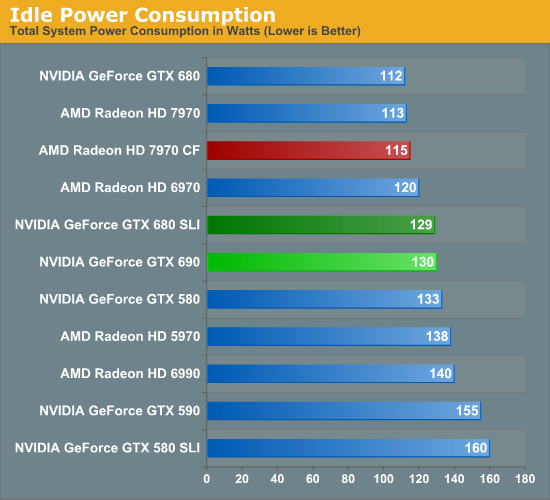
NVIDIA has progressively brought down their idle power consumption and it shows. Where the GTX 590 would draw 155W at the wall at idle, we’re drawing 130W with the GTX 690. For a single GPU NVIDIA’s idle power consumption is every bit as good as AMD’s, however they don’t have any way of shutting off the 2nd GPU like AMD does, meaning that the GTX 690 still draws more power at idle than the 7970CF. Being able to shut off that 2nd GPU really mitigates one of the few remaining disadvantages of a dual-GPU card, and it’s a shame NVIDIA doesn’t have something like this.
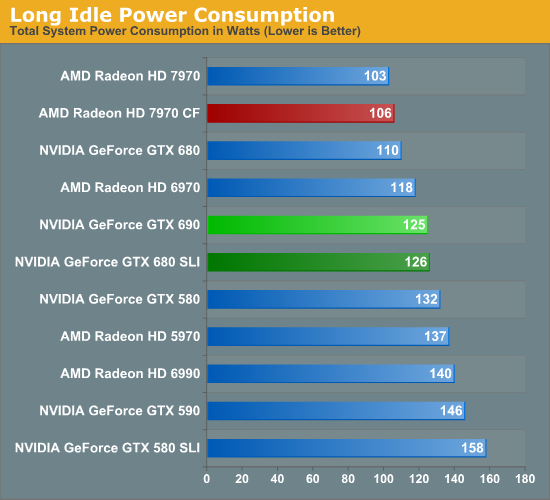
Long idle power consumption merely amplifies this difference. Now NVIDIA is running 2 GPUs while AMD is running 0, which means the GTX 690 is leading to us pulling 19W more at the wall while doing absolutely nothing.
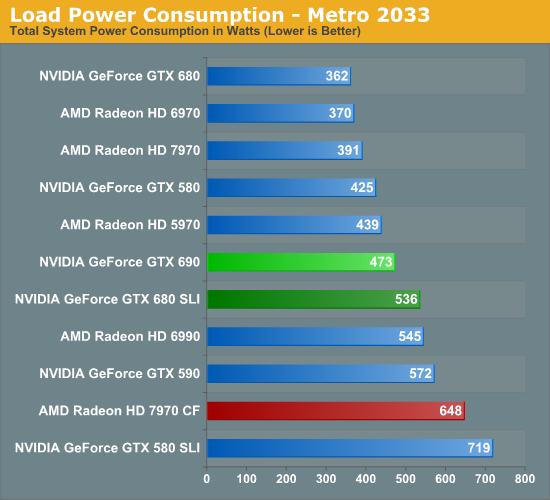
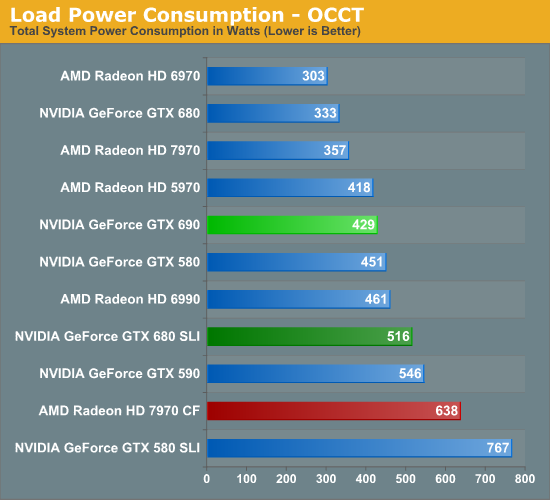
Thanks to NVIDIA’s binning, the load power consumption of the GTX 690 looks very good here. Under Metro we’re drawing 63W less at the wall compared to the GTX 680 SLI, even though we’ve already established that performance is within 5%. The gap with the 7970CF is even larger; the 7970CF may have a performance advantage, but it comes at a cost of 175W more at the wall.
OCCT power is much the same story. Here we’re drawing 429W at the wall, an incredible 87W less than the GTX 680 SLI. In fact a GTX 690 draws less power than a single GTX 580. That is perhaps the single most impressive statistic you’ll see today. Meanwhile compared to the 7970CF the difference at the wall is 209W. The true strength of multi-GPU cards is their power consumption relative to multiple cards, and thanks to NVIDIA’s ability to get the GTX 690 so very close to the GTX 680 SLI the GTX 690 is absolutely sublime here.
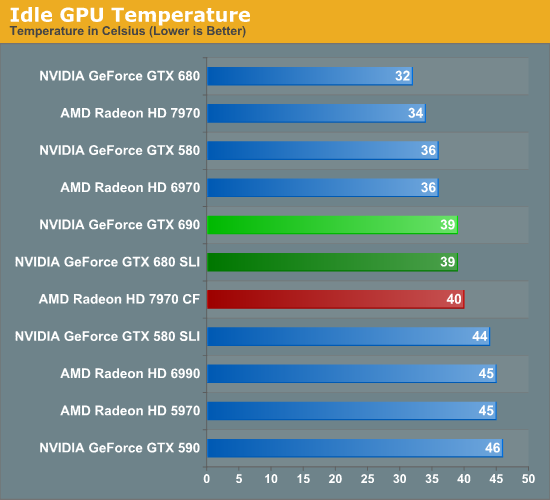
Moving on to temperatures, how well does the GTX 690 do? Quite well. Like all dual-GPU cards GPU temperatures aren’t as good as with single-GPU cards, but it’s also no worse than any dual-GPU setup. In fact of all the dual-GPU cards in our benchmark selection this is the coolest, beating even the GTX 590. Kepler’s low power consumption really pays off here.
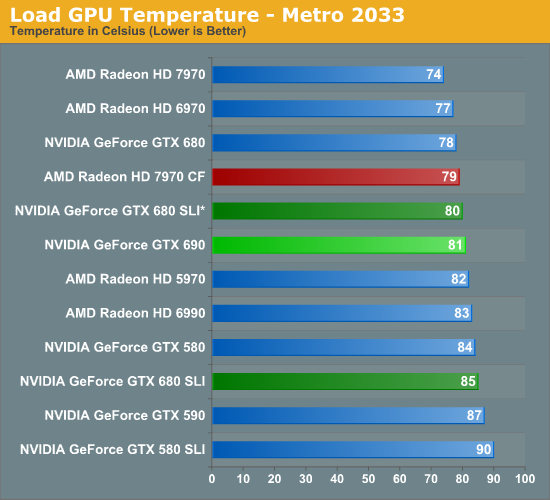

For load temperatures we’re going to split things up a bit. While our official testing protocol is to test with our video cards directly next to each other when doing multi-card configurations, we’ve gone ahead and tested the GTX 680 SLI both in an adjacent and spaced configuration, with the spaced configuration marked with a *.
When it comes to load temperatures the GTX 690 once again does well for itself. Under Metro it’s warmer than most single GPU cards, but only barely so. The difference from a GTX 680 is only 3C, 1C with a spaced GTX 680 SLI, and it’s 4C cooler than an adjacent GTX 680 SLI setup. More importantly perhaps is that Metro temperatures are 6C cooler than on the GTX 590.
As for OCCT, the numbers are different but the story is the same. The GTX 690 is 3C warmer than the GTX 680, 1C warmer than a spaced GTX 680 SLI, and 4C cooler than an adjacent GTX 680 SLI. Meanwhile temperatures are now 8C cooler than the GTX 590 and even 6C cooler than the GTX 580.
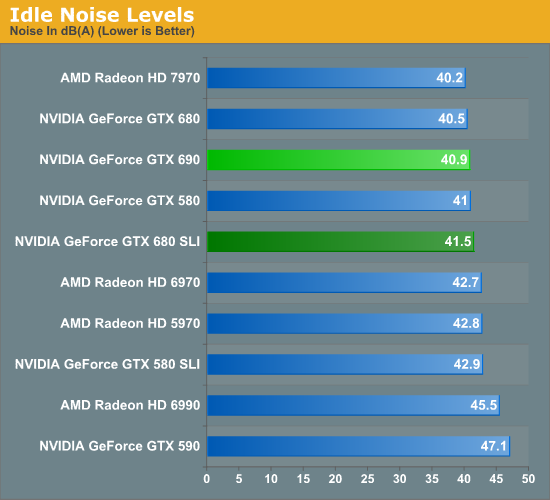
So the GTX 680 does well with power consumption and temperatures, but is there a noise tradeoff? At idle the answer is no; at 40.9dB it’s effectively as quiet as the GTX 680 and incredibly enough over 6dB quieter than the GTX 590. NVIDA’s progress at idle continues to impress, even if they can’t shut off the second GPU.


When NVIDIA was briefing us on the GTX 690 they said that the card would be notably quieter than even a GTX 680 SLI, which is quite the claim given how quiet the GTX 680 SLI really is. So out of all the tests we have run, this is perhaps the result we’ve been the most eager to get to. The results are simply amazing. The GTX 690 is quieter than a GTX 680 SLI alright; it’s quieter than a GTX 680 SLI whether the cards are adjacent or spaced. The difference with spaced cards is only 0.5dB under Metro, but it’s still a difference. Meanwhile with that 55.1dB noise level the GTX 690 is doing well against a number of other cards here, effectively tying the 7970 and beating out every other multi-GPU configuration on the board.
OCCT is even more impressive, thanks to a combination of design and the fact that NVIDIA’s power target system effectively serves as a throttle for OCCT. 55.8dB is not only just a hair louder than under Metro, but it’s still a hair quieter than a spaced GTX 680 SLI setup. It’s also quieter than a 7970, a GTX 580, and every other multi-GPU configuration we’ve tested. The only thing it’s not quieter than is the GTX 680 and the 6970.
With all things considered the GTX 690 is not that much quieter than the GTX 590 under gaming loads, but NVIDIA has improved performance just enough that they can beat their own single-GPU cards in SLI. And at the same time the GTX 690 consumes significantly less power for what amounts to a temperature tradeoff of only a couple of degrees. The fact that the GTX 690 can’t quite reach the GTX 680 SLI’s performance may have been disappointing thus far, but after looking at our power, temperature, and noise data it’s a massive improvement on the GTX 680 SLI for what amounts to a very small gaming performance difference.










200 Comments
View All Comments
CeriseCogburn - Friday, May 4, 2012 - link
I disagreechadwilson - Thursday, May 3, 2012 - link
I have some issues with this article, the first of course being availability. Checking the past week, I have yet to see any availability of the 680 besides $200+ over retail premium cards on ebay. How can you justify covering yet another paper launch card without blaring bold print caveats, that for all intents and purposes, nVidia can't make for a very long time? There is a difference between ultra rare and non-existant.Is a card or chip really the fastest if it doesn't exist to be sold?
Second, the issue of RAM, that's a problem in that most games are 32 bit, and as such, they can only address 3.5GB of RAM total between system and GPU RAM. This means you can have 12GB of RAM on your video card and the best you will ever get is 3GB worth of usage.
Until games start getting written with 64 bit binaries (which won't happen until Xbox 720 since almost all PC games are console ports), anything more than 2-3GB GPU RAM is wasteful. We're still looking at 2014 until games even START using 64 bit binaries.
Want it to change? Lobby your favorite gaming company. They're all dragging their feet, they're all complicit.
Ryan Smith - Thursday, May 3, 2012 - link
Hi Chad;While I'm afraid we're not at liberty to discuss how many 680 and 690 cards NVIDIA has shipped, we do have our ears to the ground and as a result we have a decent idea as to how many have shipped. Suffice it to say, NVIDIA is shipping a fair number of cards; this is not a paper launch otherwise we would be calling NVIDIA out on it. NVIDIA absolutely needs to improve the stock situation, but at this point this is something that's out of their hands until either demand dies down or TSMC production picks up.
-Thanks
Ryan Smith
silverblue - Thursday, May 3, 2012 - link
The 690 is a stunning product... but I'm left wanting to see the more mainstream offerings. That's really where NVIDIA will make its money, but we're just left wondering about supply issues and the fact that AMD isn't suffering to the same degree.CeriseCogburn - Sunday, May 6, 2012 - link
A single EVGA GTX680 sku at newegg has outsold the entire line up of 7870 and 7850 cards combined with verified owners reviews.So if availability is such a big deal, you had better ask yourselves why the 7870 and 7850 combined cannot keep pace with a single EVGA 680 card selling at Newegg.
Go count them up - have at it - you shall see.
108 sales for the single EVGA 680, more than the entire combined lot of all sku's in stock and out of the 7870 and 7850 combined total sales.
So when you people complain, I check out facts - and I find you incorrect and failing almost 100% of the time.
That's what happens when one repeats talking points like a sad PR politician, instead of checking available data.
ltcommanderdata - Thursday, May 3, 2012 - link
Have you considered using WinZip 16.5 with it's OpenCL accelerated file compression/decompression as a compute benchmark? File compression/decompression is a common use case for all computer users, so could be the broadest application of GPGPU relevant to consumers if there is an actual benefit. The OpenCL acceleration in WinZip 16.5 is developed/promoted in association with AMD so it'll be interesting to see if it is hobbled on nVidia GPUs, as well as how well if scales with GPU power, whether it scales with SLI/dual GPU cards, and whether there are advantages with close IGP-CPU integration as with Llano and Ivy Bridge.ViRGE - Thursday, May 3, 2012 - link
Doesn't WinZip's OpenCL mode only work with AMD cards? If so, what use would that be in an NVIDIA review?ltcommanderdata - Thursday, May 3, 2012 - link
I actually don't know if it's AMD only. I know AMD worked on it together with WinZip. I just assumed that since it's OpenCL, it would be vendor/platform agnostic. Given AMD's complaints about use of vendor-specific CUDA in programs, if they developed an AMD-only OpenCL application, I would find that very disappointing.ViRGE - Thursday, May 3, 2012 - link
Going by their website it's only for AMD cards."WinZip has been working closely with Advanced Micro Devices (AMD) to bring you a major leap in file compression technology. WinZip 16.5 uses OpenCL acceleration to leverage the significant power of AMD Fusion processors and AMD Radeon graphics hardware graphics processors (GPUs). The result? Dramatically faster compression abilities for users who have these AMD products installed! "
CeriseCogburn - Friday, May 4, 2012 - link
Oh, amd the evil company up to it's no good breaking of openCL misdeeds again.Wow that's evil- the way it's meant to be unzipped.